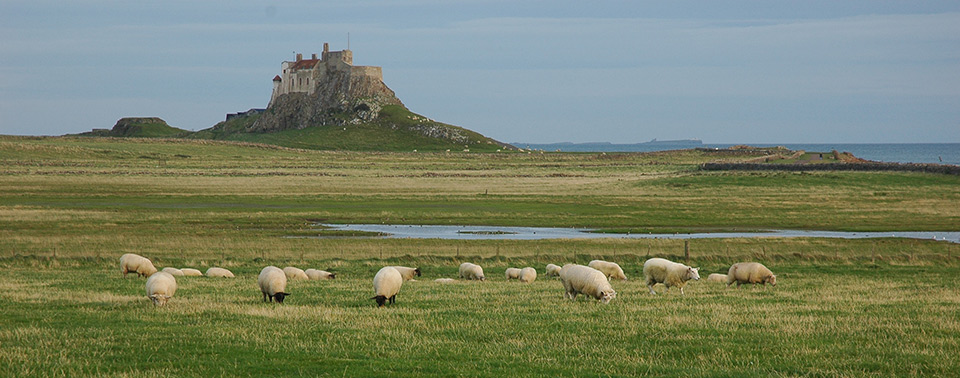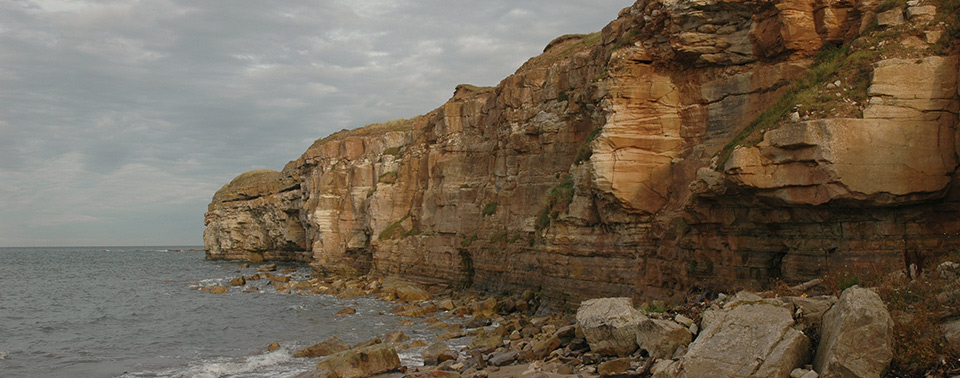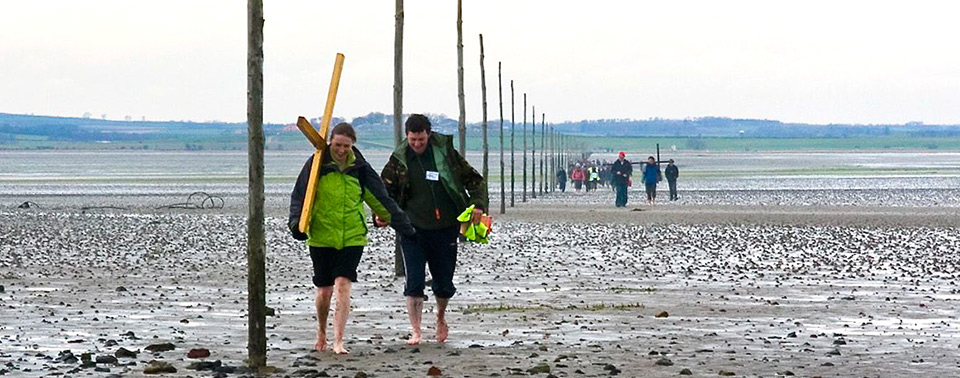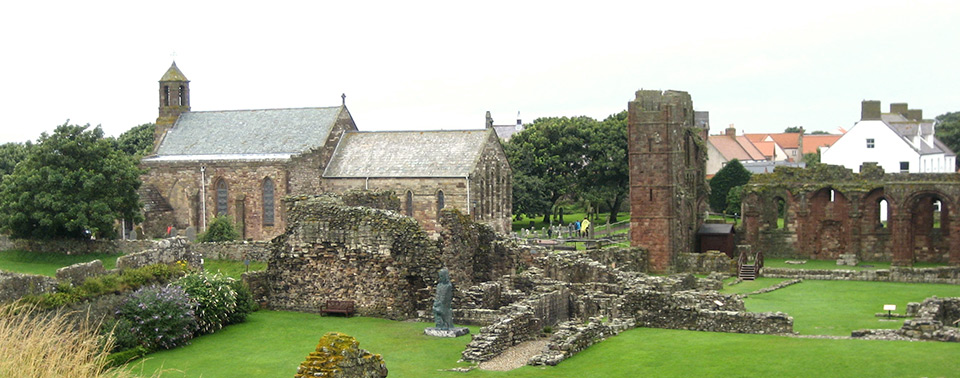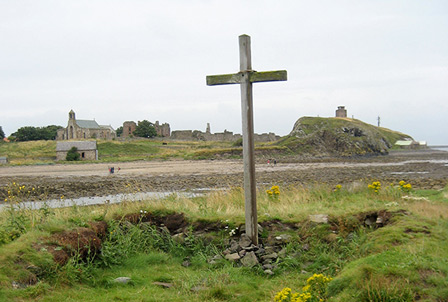Suíomh:
Is é an Oileán Naofa Lindisfarne agus bogaigh mhuirí mórthimpeall limistéar tábhachtach do ghnáthóga cósta agus éanlaithe fiáine geimhrithe. Tá sé ina Chríostaí naofa suíomh agus ionad oilithreachta ó AD 635 nuair a bhí sé ról lárnach mar "cradle" na Críostaíochta i dtuaisceart na Breataine. Measadh go raibh Ceann de na príomhchúiseanna le naomh Naomh Cuthbert mar cheann de Shasana 'caomhantóirí nádúr' an chéad agus tá sé fós ar an naomh is mó aitheanta sa cheantar. Tá chuid den oileán agus na bogaigh mórthimpeall Anaclann Dúlra Náisiúnta, cé go tithe an t-oileán féin sráidbhaile, foirgnimh stairiúla, roinnt eaglaisí agus ionaid Retreat. Le blianta beaga anuas, tá sé óstáil méadú ar líon na gcuairteoirí agus oilithrigh. Tá na héilimh de na cuairteoirí ar an acmhainneacht a chur faoi deara éagothroime idir na luachanna hoileáin lena n-áirítear an oidhreacht phobail áitiúil, éiceolaíocht agus eacnamaíoch.
Choimeádaithe:
Chomh maith lena thábhacht reiligiúnach agus stairiúil is sráidbhaile tipiciúil Northumbria é Lindisfarne le pobal cónaithe beag de. 100 daoine, comhdhéanta de theaghlaigh fadbhunaithe a bhí den chuid is mó feirmeoirí agus iascairí, chomh maith le cónaitheoirí nua. Tá an daonra áitiúil ag laghdú le blianta beaga anuas, le daoine ag fágáil chun poist agus tithíocht a lorg in áiteanna eile. Tá roinnt eaglaisí áitiúla agus grúpaí Críostaí a oibríonn le chéile. Déanann Sasana Stairiúil agus an tIontaobhas Náisiúnta an oidhreacht stairiúil a bhainistiú, agus Natural England leasanna caomhnaithe an dúlra. Déanann an tIontaobhas Forbartha Pobail ionadaíocht ar an bpobal cónaithe.
Tá gach háiteanna agus na daoine naofa. Ní mór dúinn a athghabháil go, agus meas fiú an t-adhmad is lú chomh maith leis an rainforest is mó.
– An Canónach David Adam, Vicar an Oileáin Naofa (1995-2003).
Comhghuaillíocht:
Tá a sainchúram agus a bhfeidhm féin ag gach ceann de na hinstitiúidí bainistíochta ar Oileán Naofa agus go dtí gur forbraíodh Comhpháirtíocht Oileán Naofa ní raibh meicníocht ann chun an obair seo a chomhordú.. Tá an cumas ag an gcomhpháirtíocht na gníomhaithe éagsúla a thabhairt chun cothromaíocht a choinneáil sa phobal, éiceolaíochta, luachanna reiligiúnacha agus eacnamaíocha an oileáin.
Caomhnú uirlisí:
Glacann foireann Anaclann Dúlra Náisiúnta Lindisfarne páirt i roinnt cleachtas bainistíochta, lena n-áirítear innilt beostoic chun na tailte féaraigh ar mhórán speiceas a chothabháil. Déantar na héin fhiáin a chomhaireamh go míosúil mar chuid de chlár náisiúnta monatóireachta. Áirítear leis an mbainistíocht cuairteoirí rochtain ar na limistéir is íogaire a rialú, go háirithe na dumhcha. Déantar monatóireacht ar speicis choimhthíocha ionracha, an ceann is suntasaí díobh ná piripiri burr na Nua-Shéalainne, iompórtáladh olann go stairiúil do mhuilte éadach an réigiúin. Tógáil cabhsa, tógtha isteach 1954-1964, b'fhéidir ba chúis leis na hathruithe is mó ar an gcúlchiste. Mar shampla, chuir ardú áitiúil ar na réileáin gainimh i gcóngaracht an chabhsa dlús le hathrú na réileán láibe go réileáin gainimh agus riasc goirt, rud a laghdódh achar roinnt gnáthóg atá tábhachtach d'innilt éin fhiáin. Éiríonn teorainn le páirceáil le linn an bhuaicshéasúir, nuair a pháirceálann carranna feadh an phríomhbhóthair rochtana in aice leis na dumhcha; Sasana Nádúrtha, an foras caomhantais atá freagrach as tearmainn dúlra Shasana a dhearbhú agus a bhainistiú, faoi roinnt brú chun é seo a chosc.
Torthaí:
Tá feasacht atá ag fás gur chóir go mbeadh institiúidí ar leith d'aidhm ag obair le chéile níos mó. An 2005 Nádúrtha Sasana fhís Lindisfarne Náisiúnta Nádúrtha Cúlchiste béim ar iomlánaíoch agus cur chuige comhtháite. Is é an sá Forbartha Pobail leathnú a sainchúram agus a fháil i dtaithí, agus dá bhrí sin níos fearr chun ionadaíocht a dhéanamh leis an bpobal le hinstitiúidí níos mó ar bhonn níos cothroime. Is féidir le roinnt baill an phobail ina gcónaí anois go háitiúil ag costais inacmhainne, cuidiú a choinneáil ar an croílár an cultúr áitiúil slán.
Fís:
Tá an oileán Naofa Lindisfarne á bhainistiú ag raon leathan na n-institiúidí, go léir leis an intinn a chaomhnú gné den láithreán, a bheith reiligiúnacha sé, nádúrtha nó cultúir. Nuair a d'iarr an cheist "atá i gceannas ar an talamh Naofa?, Is é an freagra uilíoch "aon duine". Cé go mbeadh struchtúr amháin chun treoir a chur ar fáil a bheith idir mí-oiriúnach agus éifeachtach, d'fhéadfadh tuiscint níos fearr comhchoiteann treo a bheith ag teastáil.
Gníomh:
Tá clár oibre gníomhach ag gach ceann de na hinstitiúidí chun aghaidh a thabhairt ar a sainréimsí oibre. Tá sé tábhachtach ó thaobh an phobail de go bhfuil aon teach déag nua tógtha ag an Iontaobhas Forbartha Pobail atá ar cíos do bhaill an phobail atá ag iarraidh fanacht ar an oileán ach nach bhfuil in acmhainn na praghsanna arda tithe a bheith acu.. Tá na chéad chéimeanna á nglacadh anois i dtreo a leithéid de phróiseas le bunú na comhpháirtíochta Oileán Naofa molta. Tá sé seo ina luathchéimeanna agus níl sé ar eolas go forleathan i measc cuid de na príomhghníomhaithe. Cé gur dócha go mbeidh fóram riachtanach, b'fhéidir nach leor é, go háirithe ag an tús; d'fhéadfadh go mbeadh gá le próiseas chun comhdhearcadh a thógáil chun teagmháil a dhéanamh le grúpa níos leithne daoine seachas ionadaithe an fhóraim.
Polasaí agus Dlí:
Níl meicníochtaí soiléire curtha ar bun chun plé a dhéanamh nó a chinneadh an trádáil-dícheangail idir físeanna éagsúla agus cosáin forbartha. Is é an oileán ag déileáil anois leis na laistigh de chreat an dlí náisiúnta. Is rialtas náisiúnta ar leibhéal an-mhór iad cuid de na himreoirí, eagraíochtaí eaglaise nó carthanachta a bhfuil sainorduithe speisialaithe acu, claonadh maorlathacha, agus meicníochtaí cinnteoireachta iargúlta agus dolúbtha, agus grúpaí tábhachtacha eile, go háirithe baill an phobail áitiúil, gan guth foirmiúil a bheith acu sa phróiseas cinnteoireachta.
- Tá an cur síos suíomh a fhorbairt i gcomhar leis an Delos Tionscnamh agus a rannpháirtithe. Tá sé tar éis ó chás-staidéar níos fairsinge i láthair agus foilsíodh leis an Tionscnamh Delos.
- Lindisfarne Oileán Naofa: www.lindisfarne.org.uk
- Wild T. (2010) Nádúr Naomh agus Oileán Naofa, Luachanna Ársa i nGeilleagar Nua-Aimseartha: Tionchar Marthanach St. Cuthbert agus Lindisfarne, An Ríocht Aontaithe. I, Tá Verschuuren et al. (2010) Láithreáin Nádúrtha Naofa: Caomhnú Dúlra & Cultúr. Earth Scan, Londain.
- Wild T. Oileán Naofa Lindisfarne agus ábharthacht nua-aimseartha na ‘Nature Saints’ Ceilteach. I Mallarach, J.M; Papayannis, T. agus Väisäinen R. 2012. An Éagsúlacht na dTailte Naofa san Eoraip. Imeachtaí an An Tríú Ceardlann de Thionscnamh Delos - Inari/Aanaar 2010.
- An Tionscadal Scannán Naofa Talún (2011), Oileán Naomh Lindisfarne.
- Sasana Nádúrtha. "Anaclann Náisiúnta Dúlra Lindisfarne".

